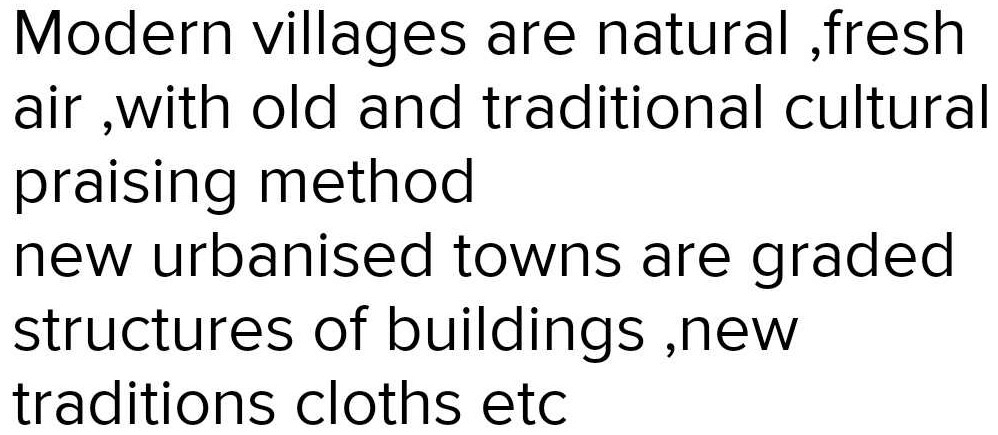Class 9 Exam > Class 9 Questions > difference between a traditional and a modern...
Start Learning for Free
difference between a traditional and a modern village
?Most Upvoted Answer
difference between a traditional and a modern village Related: Extra ...
A traditional village is typically characterized by its long-standing customs, practices, and way of life that have been passed down through generations. It often follows a more agrarian or rural lifestyle, with a focus on farming, animal husbandry, and traditional crafts. Traditional villages tend to have a close-knit community where people know each other well and rely on each other for support. The architecture and infrastructure in traditional villages are usually more simplistic and reflect the local culture and materials available.
On the other hand, a modern village incorporates elements of urbanization and globalization. It may have more advanced infrastructure, such as paved roads, electricity, and modern amenities like schools, healthcare facilities, and shops. A modern village may have a more diverse economy, with residents engaged in various occupations beyond just agriculture. The lifestyle in modern villages is often influenced by technology, media, and global trends. People might have access to modern conveniences, such as smartphones, internet connectivity, and modern transportation.
Overall, the main difference between a traditional and a modern village lies in the level of technological advancement, economic diversification, and cultural influences. However, it is important to note that the distinction between the two types of villages can vary depending on the specific region and country. Some villages may exhibit a blend of traditional and modern elements, while others may lean more towards one or the other.
On the other hand, a modern village incorporates elements of urbanization and globalization. It may have more advanced infrastructure, such as paved roads, electricity, and modern amenities like schools, healthcare facilities, and shops. A modern village may have a more diverse economy, with residents engaged in various occupations beyond just agriculture. The lifestyle in modern villages is often influenced by technology, media, and global trends. People might have access to modern conveniences, such as smartphones, internet connectivity, and modern transportation.
Overall, the main difference between a traditional and a modern village lies in the level of technological advancement, economic diversification, and cultural influences. However, it is important to note that the distinction between the two types of villages can vary depending on the specific region and country. Some villages may exhibit a blend of traditional and modern elements, while others may lean more towards one or the other.
Community Answer
difference between a traditional and a modern village Related: Extra ...

Attention Class 9 Students!
To make sure you are not studying endlessly, EduRev has designed Class 9 study material, with Structured Courses, Videos, & Test Series. Plus get personalized analysis, doubt solving and improvement plans to achieve a great score in Class 9.

|
Explore Courses for Class 9 exam
|

|
Similar Class 9 Doubts
difference between a traditional and a modern village Related: Extra Question & Answers (Part - 1) - The Story of Palampur?
Question Description
difference between a traditional and a modern village Related: Extra Question & Answers (Part - 1) - The Story of Palampur? for Class 9 2024 is part of Class 9 preparation. The Question and answers have been prepared according to the Class 9 exam syllabus. Information about difference between a traditional and a modern village Related: Extra Question & Answers (Part - 1) - The Story of Palampur? covers all topics & solutions for Class 9 2024 Exam. Find important definitions, questions, meanings, examples, exercises and tests below for difference between a traditional and a modern village Related: Extra Question & Answers (Part - 1) - The Story of Palampur?.
difference between a traditional and a modern village Related: Extra Question & Answers (Part - 1) - The Story of Palampur? for Class 9 2024 is part of Class 9 preparation. The Question and answers have been prepared according to the Class 9 exam syllabus. Information about difference between a traditional and a modern village Related: Extra Question & Answers (Part - 1) - The Story of Palampur? covers all topics & solutions for Class 9 2024 Exam. Find important definitions, questions, meanings, examples, exercises and tests below for difference between a traditional and a modern village Related: Extra Question & Answers (Part - 1) - The Story of Palampur?.
Solutions for difference between a traditional and a modern village Related: Extra Question & Answers (Part - 1) - The Story of Palampur? in English & in Hindi are available as part of our courses for Class 9.
Download more important topics, notes, lectures and mock test series for Class 9 Exam by signing up for free.
Here you can find the meaning of difference between a traditional and a modern village Related: Extra Question & Answers (Part - 1) - The Story of Palampur? defined & explained in the simplest way possible. Besides giving the explanation of
difference between a traditional and a modern village Related: Extra Question & Answers (Part - 1) - The Story of Palampur?, a detailed solution for difference between a traditional and a modern village Related: Extra Question & Answers (Part - 1) - The Story of Palampur? has been provided alongside types of difference between a traditional and a modern village Related: Extra Question & Answers (Part - 1) - The Story of Palampur? theory, EduRev gives you an
ample number of questions to practice difference between a traditional and a modern village Related: Extra Question & Answers (Part - 1) - The Story of Palampur? tests, examples and also practice Class 9 tests.

|
Explore Courses for Class 9 exam
|

|
Suggested Free Tests
Signup for Free!
Signup to see your scores go up within 7 days! Learn & Practice with 1000+ FREE Notes, Videos & Tests.

























